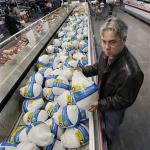12 May, 2019
The kinds of birds coming through your neighborhood are probably changing, and so is the timing of their migrations.
Birdwatchers noticing these differences are playing a big part in understanding how climate change and severe weather events are affecting bird populations.
John Rowden is director of community conservation at the National Audubon Society, which aims to protect birds and their environments. He said, "Birders have to be much more alert to when birds are coming through than they used to be, since birds may be coming through much earlier or much later..."

FILE - A warbler is seen sitting on a branch during a bird count on the Gulf Coast in Grand Isle, Louisiana.
Birdwatchers are increasingly seeing birds in their area that are usually found elsewhere, Rowden says. And, they are seeing fewer of the birds that usually travel through.
"...Just because we've seen these birds (year after year) doesn't mean they'll always be there. They are declining in numbers because we're throwing so many things at them, so we need to do what we can to help them," Rowden said.
At least 314 species of American birds are expected to lose 50 percent or more of their range by the end of the century. Those species are listed by the Audubon Society as climate-threatened or endangered, Rowden added.
A United Nations science report issued Monday says 1 million species of plants and animals are at risk of disappearing from Earth.
Scientists who issued the report blamed development that has led to loss of habitat as well as climate change, overfishing, pollution and invasive species.
Environmentalists say there are a few easy steps people can take to help struggling bird populations. These include planting native species, which leads to more native insects for the birds to eat.
The Audubon Society's Plants for Birds web page provides plant suggestions for people in the United States, based on where they live in the country.
During spring and fall migration seasons, people can help migrating birds by keeping outdoor lights turned off and covering reflective surfaces like large windows. People also should make indoor plants less visible to passing birds.
The Audubon Society also runs a community science program called Climate Watch. It aims to collect data on how bird ranges -- or the places they are found -- are changing. Rowden says the program asks people to count the numbers of each species they see. The program goes from May 15 to June 15.
Geoff LeBaron, director of the Christmas Bird Count at the National Audubon Society, says he has seen the effects of climate change firsthand.
"I've been a birder since I was a little kid," he said. "It's clear that climate change is affecting and will continue to affect birds on a global scale, and it's a question of whether or not they can adapt to what the climate is throwing at them."
Record droughts, floods, hurricanes and more are having a major effect, he says. Hurricanes usually happen during migration season, LeBaron noted. They have an especially big effect on sea birds, whose migration paths might change by thousands of kilometers as a result.
Experts say sea birds and grasslands birds are most at risk from climate disasters. Birds known as aerial insectivores are also at risk because the insects they eat are getting harder to find.
I'm Ashley Thompson.
The Associated Press reported this story. Ashley Thompson adapted it for VOA Learning English. Caty Weaver was the editor.
Write to us in the Comments Section or on 51VOA.COM.
_
Words in This Story
migration - n. the act of moving from one area to another at different times of the year
alert - adj. able to think clearly and to notice things
decline - v. to become lower in amount or less in number
range - n. the area in which an animal or plant naturally lives
habitat - n. the place or type of place where a plant or animal naturally or normally lives or grows
species - n. a group of animals or plants that are similar and can produce young animals or plants
reflective - adj. causing light, sound, or heat to move away
visible - adj. able to be seen
global - adj. involving the entire world
drought - n. a long period of time during which there is very little or no rain
aerial - adj. performed in the air
insectivore - n. an animal that eats insects









